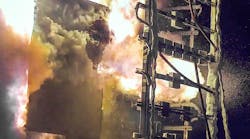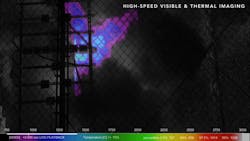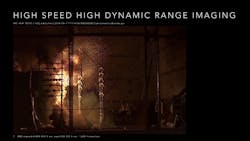High-Speed Movies Reveal Behavior of High-Energy Arc Flashes
High-energy arcing faults or flashes are high-power electrical discharges between two or more conductors; they can release tens of thousands of amps of current and occur very quickly. They can also cause explosions with temperatures of 63,000°F (35,000°C), about the temperature of lightning strikes, vaporizing steel and spewing hot metal particles into the air.
To learn more about this phenomena—and perhaps, how to prevent it—researchers at Sandia National Laboratory are using high-speed cameras and advanced imaging and analytic methods to understand dangerous arc faults between two conductors, such as the high-voltage bus bars in switchgears at power plants.
Power plants currently asses the risks from arc faults based on their zone of influence—i.e., the distance at which the fault will catastrophically damage cables and equipment. Until now, precise data about rapidly evolving arc faults has been difficult to collect. The faults create bright flames and smoke that obscure the view, and the heat can destroy most diagnostic equipment. The electromagnetic interference (EMI) created by the flash also causes problems with data collection.
For a video showing a high-energy arc fault’s power and intensity as it vaporizes a steel panel of power plant equipment, click here.
To overcome those challenges, Sandia optical engineers borrowed some cameras that are usually trained on blast tubes and rocket sleds. Data from the films will be used to write a computer program that predicts an arc fault’s zone of influence. The results could be applied to low- or medium-voltage cabinets at any manufacturing plant, says Chris LaFleur, the fire protection engineer who led the Sandia effort.
Conductors running though these electrical cabinets were traditionally made of copper, and zones of influence established over the past 50 years were based on faults involving copper conductors. But recently, many bus bars have aluminum conductors or a combination of copper and aluminum. Aluminum, although less expensive and lighter than copper, is much more reactive during a high-energy arc fault. This difference affects the level of energy and material in an arc fault.
To learn about the impact of an arc fault in a full range of electrical equipment with both copper and aluminum conductors, researchers took their commercial high-speed and infrared cameras to KEMA Laboratories in Chalfont, Penn., an independent testing lab with electrical equipment that can create high-energy arc fault conditions.
Sandia’s engineers have developed imaging and analytic methods that show several kinds of data in one video. After collecting video during a test, the group uses algorithms to stabilize and merge footage from several multiple cameras. So, this video combines thermal imaging of a high-energy arcing fault with high-speed footage to show temperature in relation to the fault.
The cameras were placed behind a cinder-block wall to get them close to the arc fault while also protecting them from the heat. For added protection, the cameras were pointed toward high-grade mirrors and recorded the explosion’s reflection at more than 1,000 frames per second.
The team recorded an arc fault involving 26,000 amps of current that lasted four seconds. Reviewing the high-speed footage, researchers saw the steel panel enclosing the switchgear vaporized within half a second of the arc initiation.
For the arc fault tests, the fire protection engineers wanted to see through the smoke and monitor the temperature of the flames. So, Tanbakuchi and Demosthenous also filmed the explosion using thermal imaging. They combined that footage with a view from a high-speed camera recording visible light from the explosion. The results showed the temperature profile of the explosion relative to the physical equipment without smoke obscuring the view. These efforts let researchers use the video as test data.
Click here for a high-speed video of a high-energy fault with high dynamic range.
Another challenge involved accounting for bright flames and shaking cameras. Tanbakuchi and Demosthenous set up three high-speed cameras to record an explosion. Each was set to a different exposure, so that combining the views produced high-dynamic-range footage with more detail in the bright and dark areas of the image. Then they stabilized the footage with a specialized computer program. The result is a video with enough visual contrast to see where the ejected particles at the edge of the explosion traveled. The particles’ movement helped LaFleur track how the explosion turns energy into speed, momentum, chemical reactions, and electrical energy.
Sandia researchers also mounted small rectangles of carbon tape and silica aerogel at various distances in front of the explosion. Ejected particles stuck to these materials, which they took back to their lab for further analysis. The particles’ sizes, shapes, and chemical compositions yields clues to reactions that occurred during the explosion.
LaFleur and her colleagues hope to use this test data to create a computer model that accounts for the energy, mass, and momentum balances during arc faults. This will let them better define the zones of influence for high-energy arc faults of given voltages and currents in a cabinet with specific metal conductors. This information will help nuclear power plant operators and others do risk analysis.




